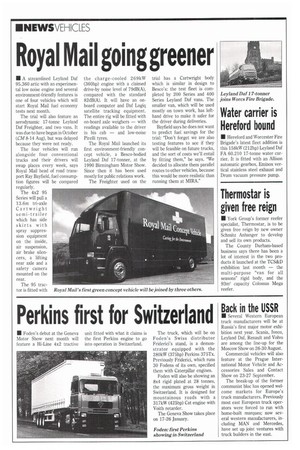Royal Mail going greener
Page 10

If you've noticed an error in this article please click here to report it so we can fix it.
• A streamlined Leyland Daf 95.360 artic with an experimental low noise engine and several environment-friendly features is one of four vehicles which will start Royal Mail fuel economy tests next month.
The trial will also feature an aerodynamic 17-tonne Leyland Daf Freighter, and two vans. It was due to have begun in October (CM 8-14 Aug), but was delayed because they were not ready.
The four vehicles will run alongside four conventional trucks and their drivers will swap places every week, says Royal Mail head of road transport Ray Bayfield, fuel consumption figures will be compared regularly.
The 4x2 95 Series will pull a 13.6m tri-axle Cartwright semi-trailer which has side skirts with spray suppression equipment on the inside, air suspension, air brake silencers, a lifting rear axle and a safety camera mounted on the rear.
The 95 tractor is fitted with the charge-cooled 269kW (360hp) engine with a claimed drive-by noise level of 79dB(A), compared with the standard 82dB(A). It will have an onboard computer and Daf Logiq satellite tracking equipment. The entire rig will be fitted with on-board axle weighers — with readings available to the driver in his cab — and low-noise Pirelli tyres.
The Royal Mail launched its first environment-friendly concept vehicle, a Besco-bodied Leyland Daf 17-tanner, at the 1990 Birmingham Motor Show. Since then it has been used mostly for public relations work.
The Freighter used on the trial has a Cartwright body which is similar in design to Besco's: the test fleet is completed by 200 Series and 400 Series Leyland Daf vans. The smaller van, which will be used mostly on town work, has lefthand drive to make it safer for the driver during deliveries.
Bayfield says he does not want to predict fuel savings for the trial: "Don't forget We are also testing features to see if they will be feasible on future trucks, and the sort of costs we'll entail by fitting them," he says. "We decided to allocate them parallel routes to other vehicles, because this would be more realistic than running them at MIRA."
















































































